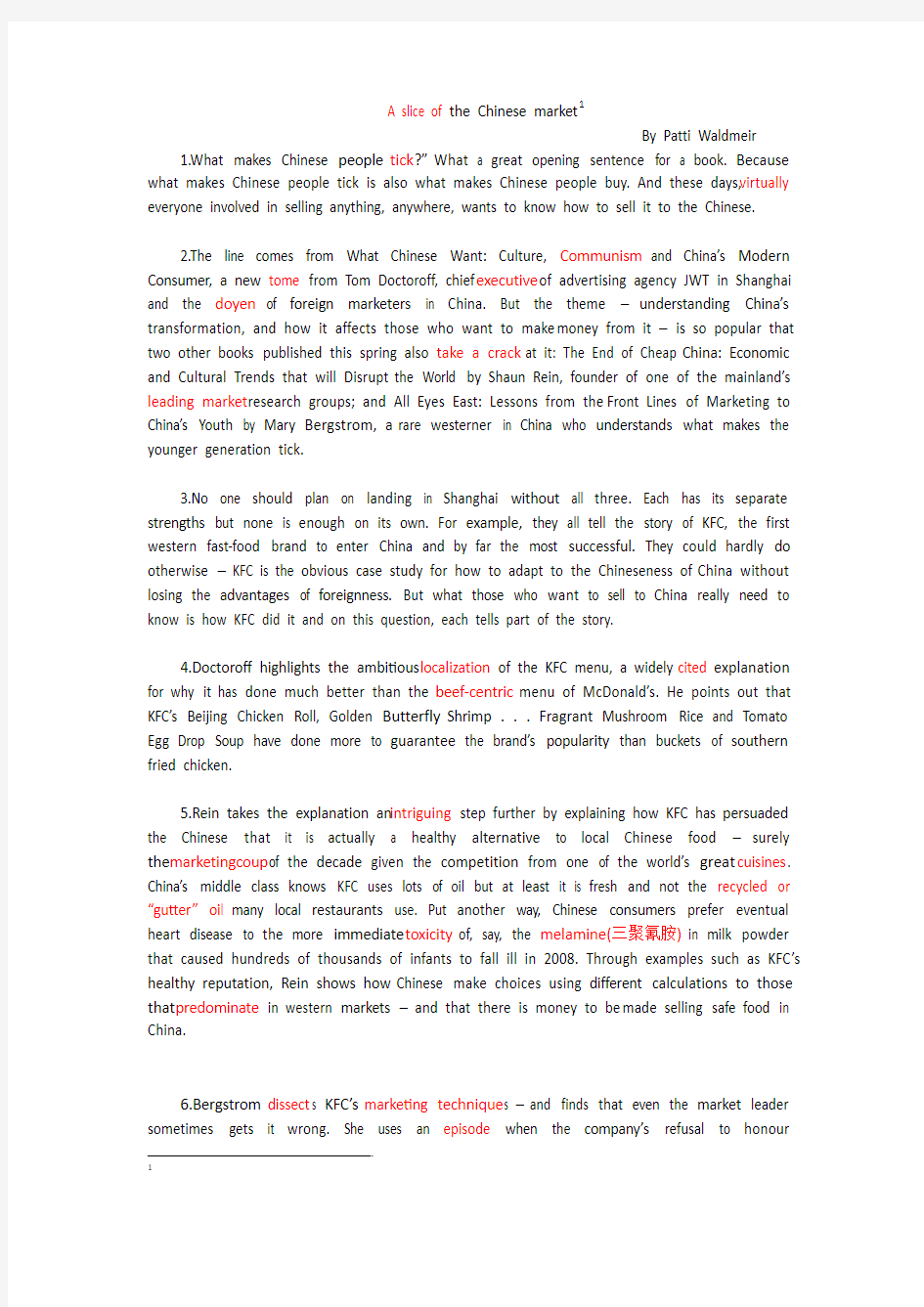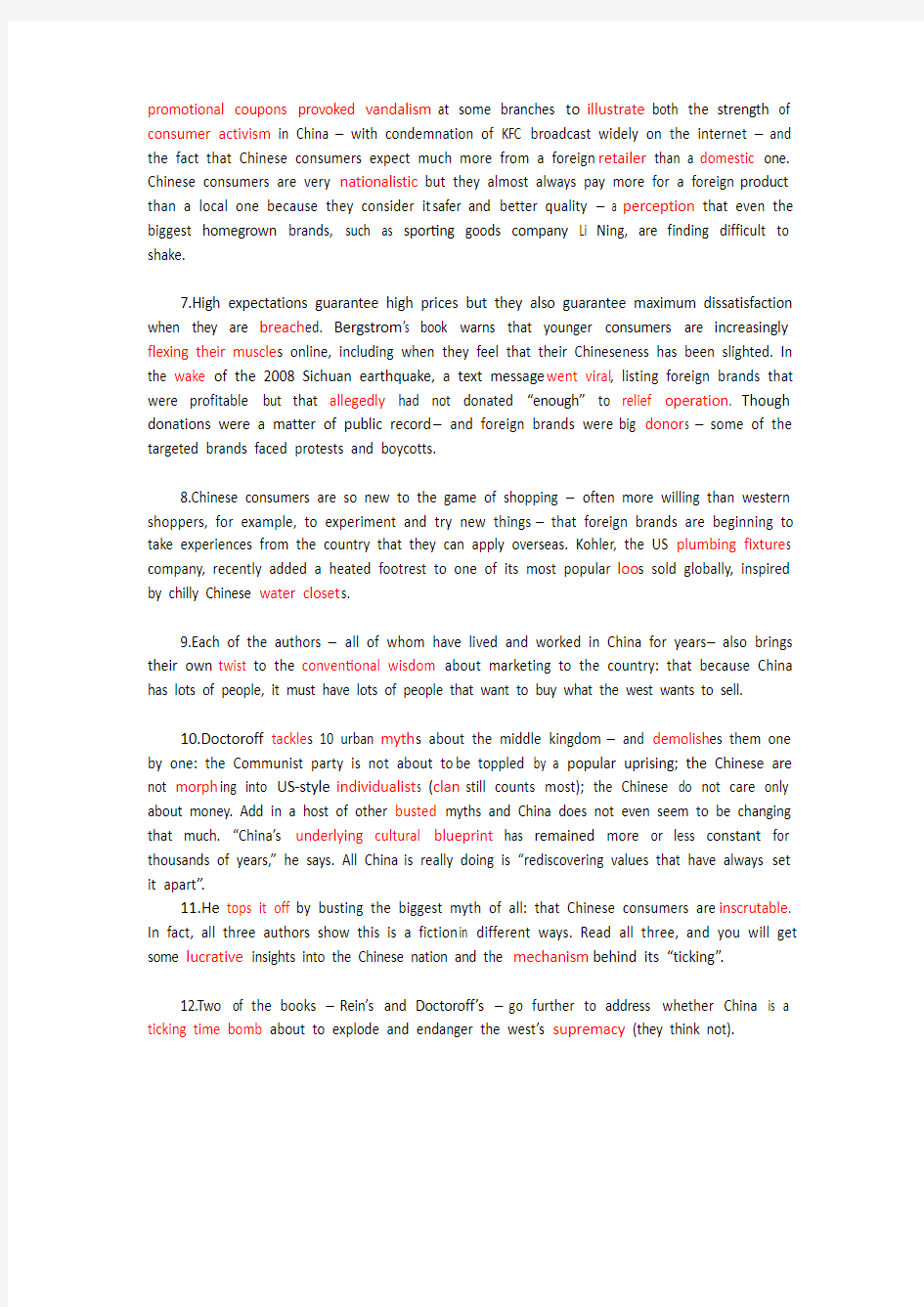A slice of the Chinese market -


A slice of the Chinese market1
By Patti Waldmeir
1.What makes Chinese people tick?”What a great opening sentence for a book. Because what makes Chinese people tick is also what makes Chinese people buy. And these days,virtually everyone involved in selling anything, anywhere, wants to know how to sell it to the Chinese.
2.The line comes from What Chinese Want: Culture, Communism and China’s Modern Consumer, a new tome from Tom Doctoroff, chief executive of advertising agency JWT in Shanghai and the doyen of foreign marketers in China. But the theme –understanding China’s transformation, and how it affects those who want to make money from it – is so popular that two other books published this spring also take a crack at it: The End of Cheap China: Economic and Cultural Trends that will Disrupt the World by Shaun Rein, founder of one of the mainland’s leading market research groups; and All Eyes East: Lessons from the Front Lines of Marketing to China’s Youth by Mary Bergstrom, a rare westerner in China who understands what makes the younger generation tick.
3.No one should plan on landing in Shanghai without all three. Each has its separate strengths but none is enough on its own. For example, they all tell the story of KFC, the first western fast-food brand to enter China and by far the most successful. They could hardly do otherwise – KFC is the obvious case study for how to adapt to the Chineseness of China without losing the advantages of foreignness. But what those who want to sell to China really need to know is how KFC did it and on this question, each tells part of the story.
4.Doctoroff highlights the ambitious localization of the KFC menu, a widely cited explanation for why it has done much better than the beef-centric menu of McDonald’s. He points out that KFC’s Beijing Chicken Roll, Golden Butterfly Shrimp?.?.?.?Fragrant Mushroom Rice and Tomato Egg Drop Soup have done more to guarantee the brand’s popularity than buckets of southern fried chicken.
5.Rein takes the explanation an intriguing step further by explaining how KFC has persuaded the Chinese that it is actually a healthy alternative to local Chinese food –surely the marketingcoup of the decade given the competition from one of the world’s great cuisines. China’s middle class knows KFC uses lots of oil but at least it is fresh and not the recycled or “gutter” oi l many local restaurants use. Put another way, Chinese consumers prefer eventual heart disease to the more immediate toxicity of, say, the melamine(三聚氰胺)in milk powder that caused hundreds of thousands of infants to fall ill in 2008. Through examples such as KFC’s healthy reputation, Rein shows how Chinese make choices using different calculations to those that predominate in western markets – and that there is money to be made selling safe food in China.
6.Bergstrom dissect s KFC’s marketing technique s –and finds that even the market leader sometimes gets it wrong. She uses an episode when the company’s refusal to honour
1
promotional coupons provoked vandalism at some branches to illustrate both the strength of consumer activism in China – with condemnation of KFC broadcast widely on the internet – and the fact that Chinese consumers expect much more from a foreign retailer than a domestic one. Chinese consumers are very nationalistic but they almost always pay more for a foreign product than a local one because they consider it safer and better quality – a perception that even the biggest homegrown brands, such as sporting goods company Li Ning, are finding difficult to shake.
7.High expectations guarantee high prices but they also guarantee maximum dissatisfaction when they are breach ed. Bergstrom’s book warns that younger consumers are increasingly flexing their muscle s online, including when they feel that their Chineseness has been slighted. In the wake of the 2008 Sichuan earthquake, a text message went viral, listing foreign brands that were profitable but that allegedly had not donated “enough” to relief operation. Though donations were a matter of public record – and foreign brands were big donor s –some of the targeted brands faced protests and boycotts.
8.Chinese consumers are so new to the game of shopping – often more willing than western shoppers, for example, to experiment and try new things – that foreign brands are beginning to take experiences from the country that they can apply overseas. Kohler, the US plumbing fixture s company, recently added a heated footrest to one of its most popular loo s sold globally, inspired by chilly Chinese water closet s.
9.Each of the authors – all of whom have lived and worked in China for years – also brings their own twist to the conventional wisdom about marketing to the country: that because China has lots of people, it must have lots of people that want to buy what the west wants to sell.
10.Doctoroff tackle s 10 urban myth s about the middle kingdom – and demolish es them one by one: the Communist party is not about to be toppled by a popular uprising; the Chinese are not morph ing into US-style individualist s (clan still counts most); the Chinese do not care only about money. Add in a host of other busted myths and China does not even seem to be changing that much. “China’s underlying cultural blueprint has remained more or less constant for thousands of years,” he says. All China is really doing is “rediscovering values that have always set it apart”.
11.He tops it off by busting the biggest myth of all: that Chinese consumers are inscrutable. In fact, all three authors show this is a fiction in different ways. Read all three, and you will get some lucrative insights into the Chinese nation and the mechanism behind its “ticking”.
12.Two of the books –Rein’s and Doctoroff’s –go further to address whether China is a ticking time bomb about to explode and endanger the west’s supremacy (they think not).
13.The geopolitical insight s, however, are less valuable than Rein’s “prostitute metre” for gauging the country’s economic development. His book begins with a winsome young girl and ends with a hoary old streetwalker. “The uglificatio n of Chinese prostitutes is part of a broader trend,” he says, a metaphor for wider changes in the job market where bright young things are increasingly looking for more than just any old job. The Chinese are no longer willing to work for peanuts to produce goods to stock our Walmarts. As a result, they are becoming more influential as consumers rather than producers, which Rein rightly says will change how the rest of the world does business.
14.Reading three books that broadly address the same subject matter may seem unappealing. The good news is that each is brilliantly written, colourful, witty and well signposted, so that readers know the lessons they are meant to draw from each chapter before moving on to the next one.
15.These writers will not be the last to offer an answer to the question of what makes China tick. But they could be among the best of them.
summary
The passage recommends three books about what make Chinese people tick to us.They are 1.What Chinese Want: Culture, Communism and China’s Modern Consumer by Tom Doctoroff 2.The End of Cheap China: Economic and Cultural Trends that will Disrupt the World b y Shaun Rein
3、All Eyes East: Lessons from the Front Lines of Marketing to China’s Youth by Mary Bergstrom
They each are brilliantly written, colourful, witty and well signposted so that readers won't feel boring when reading.Each book has its separate strengths but none is enough on its own. For example, they all tell the story of KFC,however, they focuses on different aspects.Doctoroff highlights the ambitious localization of the KFC menu.Rein explains how KFC has persuaded the Chinese that it is actual ly a healthy alternative to local Chinese food.Bergstrom dissects KFC’s marketing techniques. What’s more, they each have put forward some viewpoints such as High expectations guarantee high prices but they also guarantee maximum dissatisfaction and China is not a ticking time bomb about to explode and endanger the west’s supremacy when they are breached and so on. So, it’s better for you to read all of the three.
